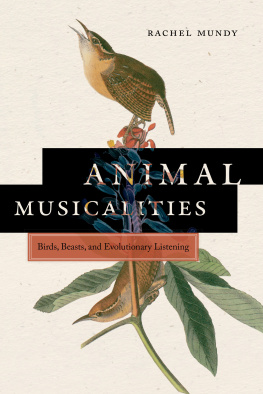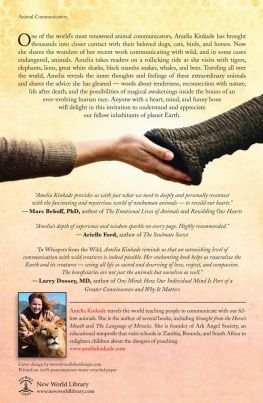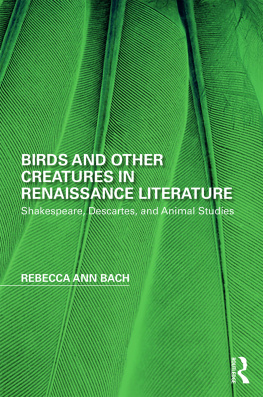
Animal Musicalities
Rachel Mundy
ANIMAL MUSICALITIES
Birds, Beasts, and Evolutionary Listening
Wesleyan University Press Middletown, Connecticut
Wesleyan University Press
Middletown CT 06459
www.wesleyan.edu/wespress
2018 Rachel Mundy
All rights reserved
Manufactured in the United States of America
Designed by Mindy Basinger Hill
Typeset in Minion Pro
Library of Congress Cataloging-in-Publication Data
Names: Mundy, Rachel, author.
Title: Animal musicalities : birds, beasts, and evolutionary listening / Rachel Mundy.
Description: Middletown, Connecticut : Wesleyan University Press, [2018] | Series: Music/culture | Includes bibliographical references and index. | Identifiers: LCCN 2018002992 (print) | LCCN 2018010580 (ebook) | ISBN 9780819578082 (ebook) | ISBN 9780819578068 (hardcovder)
Subjects: LCSH: Animal sounds. | Birdsongs.
Classification: LCC QL765 (ebook) | LCC QL765 .M86 2018 (print) | DDC 591.59/4dc23
LC record available at https://lccn.loc.gov/2018002992
54321
Cover illustration: Great Carolina Wren and Dwarf Bick-eye, John James Audubon. From Audubons Birds of America, originally published as a series between 1827 and 1838.
CONTENTS
ACKNOWLEDGMENTS
I have benefitted greatly from the help of many generous and thoughtful people while writing this book. Many mentors, colleagues, friends, and generous strangers have encouraged me to think about human and nonhuman animals during the time between my dissertation and the book you are reading now. I am particularly grateful for Suzanne Cusicks mentorship, guidance, and inspiration concerning my questions about the relationships we build with other others. Jason Stanyeks encouragement and fabulous reading recommendations gave me the confidence to get started, and to keep on writing about animals. Michael Beckerman, Elizabeth Hoffman, and Stanley Boorman provided thoughtful feedback and much-needed cheerleading during my dissertation and beyond it. Judy Tsou, Una Chaudhuri, Ana Maria Ochoa, Martin Daughtry, and Judah Cohen were generous with their time, teaching, and conversation, and helped me work through important ideas about animals, gender, historiography, and race. I have been especially fortunate in having colleagues and friends whose conversation, ideas, and critical eyes helped this project develop and grow. I especially thank Daniel Asen, Robert Fallon, Gregory Radick, David Rothenberg, Tes Slominski, Nicol Hammond, Anna Nisnevich, Emily Zazulia, and Gavin Steingo for their thoughtful and supportive readings of portions of this text. I am also indebted to my fabulous editor at Wesleyan University Press, Marla Zubel, whose insights and support were invaluable, and to the entire staff at the press for their incredible expertise, help, and high standards.
I am grateful for the institutional support that made the space this book needed to grow. Henry Martin, Lewis Porter, Ian Watson, and Dean Jan Lewis at Rutgers UniversityNewark made possible a crucial research leave in the fall of 2015. I benefitted tremendously, and am still benefitting, from the exchange of ideas and questions at the 2016 Wesleyan Race and Animals Summer Institute, and I especially thank Lori Gruen for her work hosting and organizing the institute. I am likewise indebted to Karin Bijsterveld, Joeri Bruyninckx, and the Sonic Skills Group at the University of Maastricht in 2012 and 2014, whose ideas and shared conversations helped me think through key questions about the transcription of sound. Many thanks to Deane Root, James Cassaro, Paolo Palmieri, Andrew Weintraub, and other friends and faculty at the University of Pittsburgh for their support and encouragement. This project owes so much to the enthusiasm and support of the music faculty at Columbia University during my postdoctoral fellowship in 20102012, and I am grateful as well for the American Musicological Societys Eugene K. Wolf Travel Grant, which allowed me to read my way through French ornithology journals while waiting for archival boxes at the Bibliothque nationale de France in 2010. Finally, the lively ideas and conversation of members of the American Musicological Societys ecocriticism study group gave further depth to my questions and ideas.
I am indebted in so many ways to the patience and generosity of librarians, and to the availability of collections under their care. My thanks to Suzanne McLaren and the Carnegie Museum of Natural History; to Suzanne Mudge at Indiana Universitys Archives for Traditional Music; to Mai Reitmeyer and the special collections staff at the American Museum of Natural Historys research library; and to the archivists at the American Philosophical Society Library, the New York State Archives, the New York Public Library, Yale Universitys Sterling Memorial Library Manuscripts and Archives, and the Western Michigan University Archives and Regional History Collections. And it is hardly possible to properly thank historian Dr. Richard Burkhardt, who responded to my cold-call inquiry about Wallace Craigs correspondence by sending me a cardboard box that contained his own careful photocopies of Craigs letters. Thank you so much, Dr. Burkhardt!
I am grateful to the students and colleagues whose conversations and ideas have helped me continue to discover which questions I care about, and to learn what research brings me humor, growth, and joy. Thanks to Dave Novak for his generous and thoughtful ideas about mechanical transcription, and to Ellie Hisama and Emily Wilbournes Women, Music, Power conference in 2015. I am especially indebted to my students. Their questions, ideas, and perspectives are an ongoing part of the work I care about. The students in my elective seminars in 2015 at the University of Pittsburgh had an especially important place in the making of this book: Kevin OBrien, Lu-Han Li, Danny Rosenmund, Julie Van Gyzen, Juan Velasquez, Xinyang Wang, Hety Wong, Chris Capizzi, John Petrucelli, and Jonathan Shold. Thank you all.
This book tells a story and asks questions that I care about and believe in. As you read it, I hope youll discover a new perspective on history and the people (of many sorts) we share it with. But like most scholars, I worry about all the mistakes I made. Did I misread a source? Fail to credit another authors work? Ignore a significant event, person, or place? Translate another language badly? Make it seem like this story is the only story? Whatever they are, any mistakes, errors, or shortcomings in this book are entirely mine. I hope you will be patient with them as you discover them, and learn from the things this book does best.
Last but hardly least, I am grateful for the support and love of my family. Many thanks to my siblings for their constant love and support; to my close friends; and especially to my mother, who read me nature stories when I was a child and gave me bird guides and animal books after I became an adult. Finally, I am grateful to Climber, the blue-tongued skink who has lived with me for the past seven years. He will not care about acknowledgments in a book (I gave him an egg instead), but I would be remiss not to include his silent, cool, and scaly support in my thanks.
Animal Musicalities
Introduction
In 1904, American naturalist Ferdinand Schuyler Mathews wrote that he heard a song sparrow perform La donna mobile from Verdis hit opera Rigoletto, complete with its own improvised cadenza. To hear La donna in the song of a sparrow was to hear some or all of these references.
Other listeners have heard different kinds of musicality in the song sparrows voice. Their comparisons are symptoms of a strange and expansive musical taxonomy. A few years after Mathewss comparison, another naturalist compared the sparrows tunes to the songs of ancient Greeks and medieval monks, cultural icons that, like Verdi, were heard with a mixture of reverence and condescension. These strange appraisals of sparrow music span a century of birds, and over two thousand years of human music.
Next page







